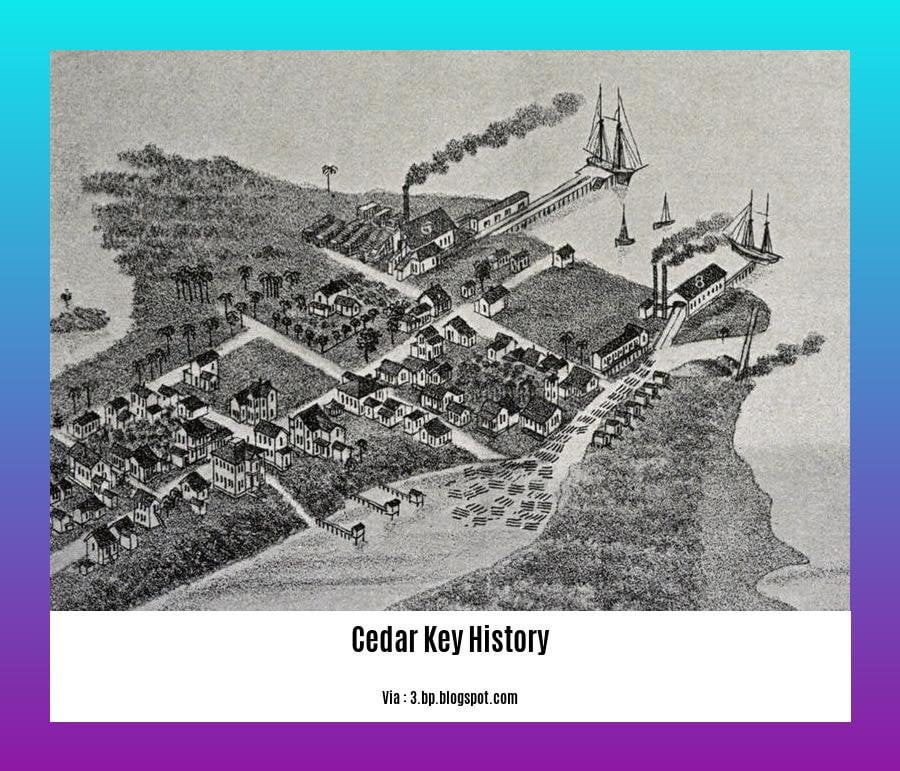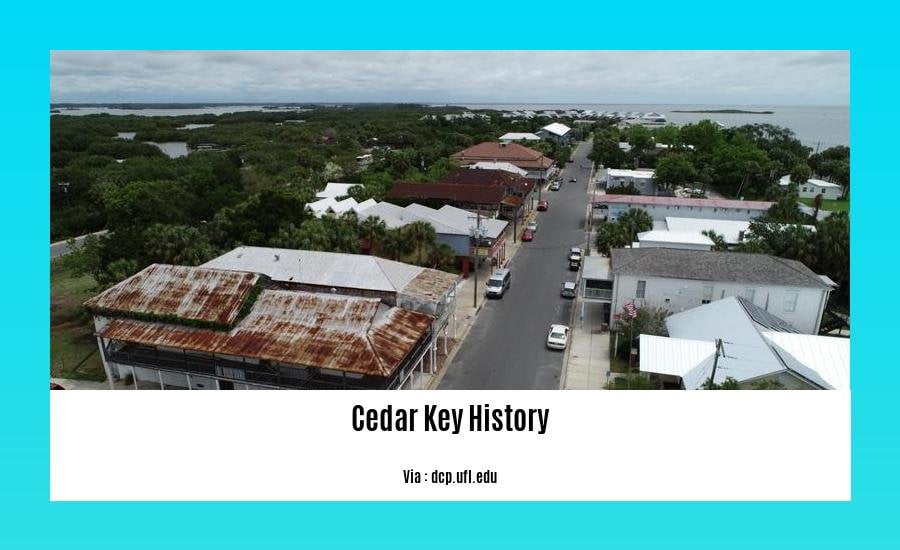Embark on a captivating voyage through time as we unveil the hidden stories of Cedar Key, a coastal gem nestled amidst the tranquil waters of Florida. Step back in time and explore the rich tapestry of this charming town, where history whispers through the wind-swept streets and echoes in the gentle lapping of waves against its shores. Join us as we delve into the depths of Cedar Key’s historical allure, uncovering the tales of resilience, triumph, and forgotten treasures that have shaped its unique identity. [Cedar Key History Map Cedar Key History Wikipedia Cedar Key History Facts]
Key Takeaways:
Cedar Key, situated on Way Key, has a rustic charm that dates back to its settlement in the early 1840s.
The town played a significant role in ending the second Seminole War, as it was where the official peace treaty was signed in 1842.
Following the war, Cedar Key transformed into a bustling port, with steamboats transporting cotton and lumber along the Gulf Coast and beyond.
The Seahorse Key Lighthouse, built in the 1850s to guide merchant ships, still stands as a testament to the town’s maritime past.
Cedar Key’s connection to the Florida Railroad in 1861 established it as the westernmost station on the line, contributing to its growth and importance.
During the Civil War, Cedar Key, being a prominent port, experienced its share of wartime activities.
Cedar Key History: Unraveling the Enigmatic Past of a Coastal Haven


Cedar Key, a coastal gem nestled amidst the azure waters of the Gulf of Mexico, is a treasure trove of captivating stories and a testament to the indomitable spirit of its people. Embark on a journey through time as we delve into the rich Cedar Key history, unveiling the hidden narratives that have shaped this enchanting town.
The Seminole Legacy: A Chapter of Resilience
In the annals of Cedar Key history, the Seminole people occupy a prominent place. Their fierce resistance against forced removal etched an indelible mark on the town’s identity. In 1842, the Second Seminole War officially concluded in Cedar Key, a poignant moment symbolizing both triumph and tragedy.
Flourishing Trade Routes: Cedar Key’s Economic Lifeline
Following the Seminole War, Cedar Key experienced a surge of prosperity as steamboats plied its waterways, carrying cotton and lumber along the Gulf Coast and beyond. This vibrant maritime trade transformed Cedar Key into a bustling hub of commerce, connecting it to distant shores and igniting an era of economic growth.
The Guiding Light: Seahorse Key Lighthouse
In the 1850s, the construction of the Seahorse Key Lighthouse marked a new chapter in Cedar Key history. This beacon of hope, perched on a small island off the coast, guided countless merchant ships safely through treacherous waters, ensuring their passage through the treacherous Gulf.
The Railroad Arrives: A Catalyst for Transformation
The arrival of the railroad in Cedar Key in 1861 marked a pivotal moment in its development. As the western station on the Florida Railroad, Cedar Key became a vital transportation hub, connecting it to the rest of the state and facilitating the movement of goods and people.
Civil War Echoes: A Town Divided
The Civil War reverberated through Cedar Key’s history, leaving an imprint of division and strife. As a significant port, the town witnessed its share of wartime skirmishes, adding to the complexity of its narrative.
Preserving the Past: A Legacy Endures
Today, Cedar Key stands as a testament to the enduring power of history. Its charming streets, lined with historic buildings, invite visitors to step back in time and immerse themselves in the town’s rich tapestry of stories. The Cedar Key Historical Society serves as a guardian of this legacy, diligently preserving and sharing the town’s heritage through engaging exhibits and educational programs.
Unveiling the Hidden Stories: A Journey of Discovery
As you wander through Cedar Key, embrace the opportunity to uncover its hidden stories. Engage with the locals, visit the historical museum, and explore the many landmarks that dot the town’s landscape. Each discovery will add a brushstroke to the vibrant portrait of Cedar Key history, deepening your appreciation for this coastal gem.
If you want to get the real outdoorsy Floridian experience, be sure to explore the Cedar Key NWR to discover the true beauty of the Nature Coast.
Cedar Key History Facts
In this section, we take a fascinating expedition through the annals of Cedar Key, delving into its deeply captivating history and unveiling the hidden stories that have shaped this coastal haven.
Key Takeaways:
Cedar Key was founded in the 1840s and served as the endpoint of the Florida Railroad during the Civil War, establishing its strategic importance as a port.
The town incorporated in 1869 with a modest population, witnessing significant growth and development over the years.
Cedar Key’s rich history intertwines with the conclusion of the Second Seminole War in 1842, marking a pivotal moment for the region.
The construction of a lighthouse on Seahorse Key in the 1850s stands as a testament to the town’s maritime heritage, guiding merchant ships safely through treacherous waters.
Steamboats carrying cotton and lumber traversed the waterways connecting Cedar Key to both domestic and international destinations, fostering economic growth and global trade.
The Alluring Shores of Cedar Key: A Timeline of Historical Milestones
1840s: The journey begins as settlers arrive on the shores of Cedar Key, establishing their roots in this serene coastal paradise.
1842: A historic turning point unfolds as the Second Seminole War concludes in Cedar Key, signifying a transformative chapter in the region’s history.
1850s: Cedar Key emerges as a bustling port town, welcoming steamboats laden with cotton and lumber, propelling its economy and forging global connections.
1850s: A beacon of hope and guidance takes form as a lighthouse is erected on Seahorse Key, illuminating the path for seafarers navigating the perilous waters.
1861: Cedar Key assumes a pivotal role as the western terminus of the Florida Railroad, underscoring its strategic importance during the Civil War era.
1869: The town officially incorporates as the Town of Cedar Keys, marking a milestone in its administrative and civic development.
Cedar Key’s Enduring Legacy: A Tapestry of Stories Yet Untold
As we traverse the historical landscape of Cedar Key, we discover a treasure trove of untold stories, each a unique thread in the intricate tapestry of the town’s rich heritage. From the bustling days of steamboat trade to its role as a Civil War port, Cedar Key’s past is a testament to its resilience, adaptability, and unwavering spirit.
Throughout the decades, Cedar Key has evolved into a vibrant community, drawing artists, writers, and nature enthusiasts to its enchanting shores. Its historic charm, coupled with its breathtaking natural beauty, makes it a captivating destination for those seeking tranquility, inspiration, and a glimpse into a bygone era.
Citations:
26 things to do in Cedar Key, a charming, historic town in North Florida
FAQ
Q1: In what year did the second Seminole War conclude in Cedar Key?
A1: The second Seminole War officially ended in Cedar Key in 1842.
Q2: What was Cedar Key’s role during the Civil War?
A2: Cedar Key served as a significant port during the Civil War due to its position as the western terminus of the Florida Railroad.
Q3: What is the significance of the lighthouse on Seahorse Key?
A3: Constructed in the 1850s, the lighthouse on Seahorse Key still stands as a vital guide for merchant ships navigating the waterways.
Q4: What was the population of Cedar Key in 1870?
A4: In 1870, the population of Cedar Key was recorded as 400.
Q5: How did steamboats impact Cedar Key’s economy after the Seminole War?
A5: Following the conclusion of the Seminole War, steamboats transporting cotton and lumber traversed the waterways, connecting Cedar Key to international trade routes.












